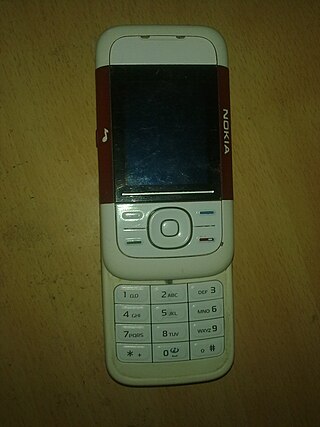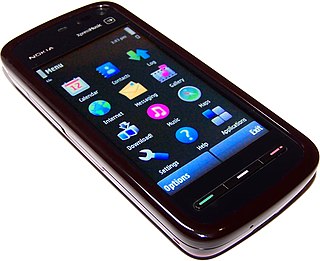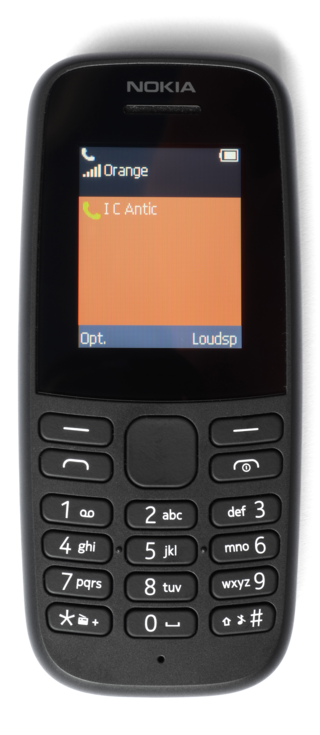Visual radio is a generic term for adding visuals to audio radio broadcasts. Visual Radio is also a trademark for a Nokia product which delivers interactive FM radio over a data connection.

The Nokia N70 is a 3G mobile phone from Nokia. It was announced as part of the Nokia's new line of multimedia smartphones, the Nseries, on 27 April 2005. It started shipping in September 2005. It runs on the S60 2nd Edition, Feature Pack 3 on Symbian v8.1 operating system. It was succeeded by the Nokia N73. The N70 was popular and sold well.
Series 40, often shortened as S40, is a software platform and application user interface (UI) software on Nokia's broad range of mid-tier feature phones, as well as on some of the Vertu line of luxury phones. It was one of the world's most widely used mobile phone platforms and found in hundreds of millions of devices. Nokia announced on 25 January 2012 that the company has sold over 1.5 billion Series 40 devices. It was not used for smartphones, with Nokia turning first to Symbian, then in 2012–2017 to Windows Phone, and most recently Android. However, in 2012 and 2013, several Series 40 phones from the Asha line, such as the 308, 309 and 311, were advertised as "smartphones" although they do not actually support smartphone features like multitasking or a fully fledged HTML browser.

The Nokia 5110 is a GSM mobile phone that was introduced by Nokia on 12 April 1998.

The Nokia N79 is a Symbian OS v9.3 mobile phone and a member of the Nokia Nseries multimedia smartphone family running on S60 3rd Edition Feature Pack 2. It was officially announced by Nokia on 26 August 2008. The N79 is an advanced device with a 5 megapixel camera, dual LED flash, and GPS, with many improvements over the Nokia N78. It retailed for 350 euros upon release in October 2008.

The Nokia N81 is a Symbian OS mobile phone announced by Nokia on 29 August 2007 and released the next month. It runs S60 3rd Edition, Feature Pack 1.

The Nokia 5200 is a Series 40 mobile phone manufactured by Nokia. Announced on 27 September 2006, it is less featured than its better counterpart, the Nokia 5300, and is not XpressMusic branded. It got its last software update in 2008.

Nokia 5300 XpressMusic is a slider mobile phone by Nokia, part of the XpressMusic range. It was introduced on 26 September 2006 and released at the end of that year. It runs on Nokia Series 40 3rd Edition FP2.

The Nokia 5310 is an XpressMusic mobile phone, introduced by Nokia on 29 August 2007 and released in the fourth quarter of 2007. It is less than a centimeter thick and is available with blue, red, purple, pink, orange, silver or black trim, the main body also being available in grey, black or white. It features many music specific features as well as a 2.0-megapixel camera. At 9.9 mm thick, it is one of few mobile phones measuring less than 1 cm thick at the time. It is one of the lightest phones Nokia has ever produced at 71 g.

The Nokia 5610 is a slider mobile phone from Nokia part of the XpressMusic series. Introduced August 2007 and launched in December, it runs on the Series 40 platform. The 5610's design is similar to that of the Nokia 5310 XpressMusic, with aluminium brushed sides and bold side colours of either red, blue, white, or pink. Above the regular D-pad with music buttons, the 5610 features a "sliding switch" below the display for navigation. The phone is shown on Panic! at the Disco "That Green Gentleman " music video.

Nokia 5700 XpressMusic is a mobile phone by Nokia, announced on March 29, 2007, as the successor to the Nokia 3250, but also looks very similar to Nokia 5300. It is a Symbian S60 3rd Edition FP1 smartphone that was sold under the XpressMusic sub-brand, which emphasises music and multimedia playback. The Nokia 5700 XpressMusic is a monoblock twistable phone which weighs 115 g. It has a casing made of glossy white plastic, and a black or red mat plastic middle section. There is a rubber flap on the right hand side which covers a microSD hotswap card slot, USB port and charging jack.

Nokia 5800 XpressMusic is a smartphone part of the XpressMusic line, announced by Nokia on 2 October 2008 in London and started shipping in November of that year. Code-named "Tube", it was the first touchscreen-equipped S60 device by Nokia – essentially it was the first device to run Symbian^1, also known as S60 5th Edition, the touch-specific S60-based platform created by the Symbian Foundation. The touchscreen features tactile feedback.

The Nokia N97 is a high-end smartphone introduced on 2 December 2008 by telecommunications manufacturer Nokia as part of its Nseries and released in June 2009 as the successor to the Nokia N96 phone. The N97 was Nokia's second S60-based touchscreen phone, after the Nokia 5800 XpressMusic. The device featured slide-out QWERTY keyboard, and ran on the Symbian v9.4 operating system. Its design took cues from the Nokia N79. A smaller and lower-cost variant, the Nokia N97 mini, was later released.

The Nokia 5320 XpressMusic is a Symbian OS S60 mobile phone, released by Nokia in 2008 as a part of their XpressMusic line of portable devices. The phone has a rugged candybar body with outlined keypads. It emphasizes music and multimedia playback. Among its highlights are a dedicated 3D audio chip for better sound quality, 24 hours of music playback, a 3.5 mm audio jack, N-Gage compatibility, and music/gaming keys. At the time of release the phone cost $220 in the U.S., European and Asian markets.

The Nokia X6 is a music-oriented capacitive touchscreen smartphone and portable entertainment device by Nokia. It was announced in early September 2009 during Nokia World 2009 in Germany.

The Nokia 5530 XpressMusic is a smartphone by Nokia announced on 15 June 2009. Part of the XpressMusic series of phones, it emphasizes music and multimedia playback. It is Nokia's third touchscreen phone based on the Symbian OS (S60) 5th edition platform.

The Nokia C6-00 is a smartphone and portable entertainment handheld cellular device by Finnish communications company Nokia, running the Symbian S60v5 operating system. It was announced on April 13, 2010. It is the third Nokia Symbian^1 smartphone featuring a full slide-out QWERTY keyboard. Its software and hardware specifications resemble the N97 mini in most ways. One of the differences is that the sliding in this phone is flat, unlike the upward angled in the N97 mini, hence allowing a four row QWERTY keypad, bringing a slightly enhanced typing experience to the table. The phone has a 5-megapixel camera, though unlike the N97 mini, it does not have Carl Zeiss optics. It also has a secondary camera in front for video calls. The Nokia C6-01 is the successor to the C6-00 featuring a major step-up with the new Symbian^3 operating system, Ovi Maps 3.0 and such but losing the QWERTY keyboard.

The Nokia Nseries was a high-end lineup of feature phones, smartphones, and tablets marketed by Nokia Corporation from 2005 to 2011. The Nseries devices commonly supported multiple high-speed wireless technologies at the time, such as 3G, or Wireless LAN. Digital multimedia services, such as music playback, photo/video capture or viewing, gaming or internet services were the central focus of the lineup. The lineup was replaced in 2011 by the Nokia Lumia line as the company's primary smartphone lineup.

Series 30+ is a software platform and application user interface used for Nokia-branded mobile devices. The platform was introduced by Nokia in September 2013, first appearing on the Nokia 108, and has been the main Nokia feature phone operating system after the end of the Series 30 and Series 40 platforms in 2014. Despite the similar name and user interface, S30+ is technically completely different and unrelated to S30.



















